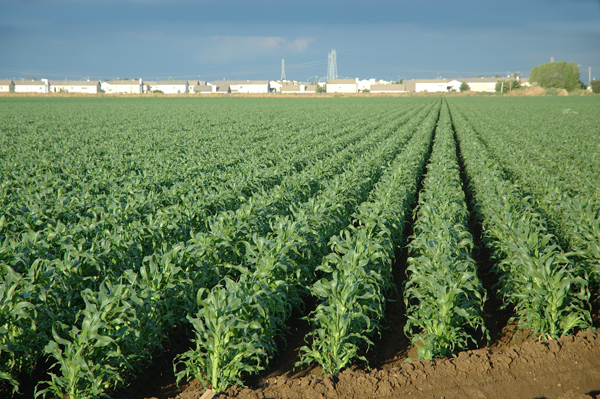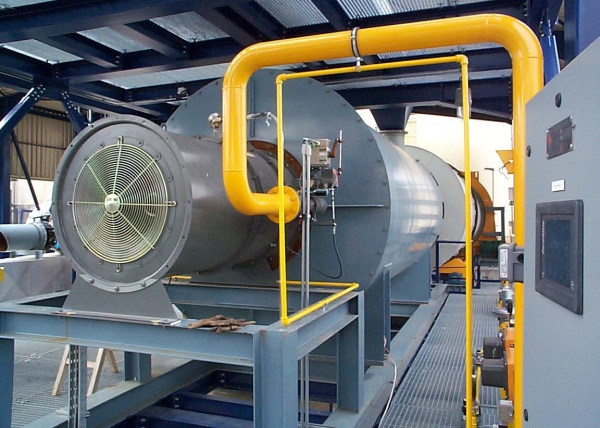Farmers are responsible for nearly every morsel of food we see on our tables each day. Whether it's crops of grains, fruits and vegetables, or feed for the animals that provide us with meat and dairy products, ensuring that growers are able to get the best possible fertilizer is not just in their best interest, but everyone's. Fertilizer dryers come into play in order to get higher yields, and to understand why, it is necessary to first take a brief look into what fertilizer does and its important role in our lives.
Plants receive the nutrients they need for survival from the soil in which they are planted. As more and more harvests are planted and replanted in the same soil, the nutrients eventually become used up, turning the soil into non-viable dirt. This makes it difficult or nearly impossible to grow crops, and it drastically impacts a farm's yield. FertilizerFertilizer replenishes these nutrients, breathing new life into dead soil and allowing the farm to grow crops like it used to -- or even better, depending on the quality of fertilizer used.
A common misconception is that fertilizer is simply animal waste that is packaged in bags and sold at local stores. While waste or compost can indeed be used as a rudimentary fertilizer, the products that can provide a significantly higher yield are achieved through a much more complicated and scientific process.
Plants use nitrogen in the synthesis of proteins, nucleic acids and hormones. Nitrogen deficiency manifests as yellowing of leaves and reduced growth. Plant growth is also reduced with the absence of phosphorous. Potassium is used in protein synthesis, and when plants lack enough of it, their stems and roots tend to weaken and yellow. Calcium, magnesium and sulfur are also important minerals. Most soils naturally contain enough of these components, so they are only included in fertilizers in small amounts. Additional micronutrients include iron, chlorine, copper, manganese, zinc, molybdenum and boron, which factor in enzymatic reactions. While they may be present in small amounts, plants can die without them.
Many different substances provide the essential nutrients for effective fertilizers. These compounds can come from naturally occurring sources, such as sodium nitrate, bone, guano, potash, phosphate rock and even seaweed. Compounds can also be chemically synthesized from basic raw materials, including ammonia, urea, nitric acid and ammonium phosphate.
To produce fertilizer in its most usable form, each of the different chemical compounds such as ammonium nitrate, potassium chloride, ammonium phosphate and triple superphosphate are dried and blended together. The drying process is an important step in the processing of fertilizer. Chemical fertilizers in granular form must have a certain percentage of moisture removed in order to be most useful. Water retention in fertilizer is a problem, as it can have a significant impact not only on the quality of the final product but also its effectiveness.
Rotary Dryersdryerscoolers.aspx are often used to dry the various components, and consist of a cylindrical shell inclined at a slight angle to the horizontal. Wet material is introduced into the upper end of the dryer and the dried product exits at the lower end. Inside the rotary shell, lifting flights constantly toss and mix the material to expose all parts of the material to the drying air.
Heyl & Pattersonheyl patterson inc 29440.htm rotary dryers are among the most versatile available for drying fertilizer, and are capable of handling almost any bulk solid material regardless of its conveyance and handling characteristics. These rotary dryers can be configured to meet a wide range of needs and applications. Factors such as starting and final moisture content, product temperature, drying air temperature, air velocity and retention time of the material in the dryer are all considered in the specifications. Applications and designs for fertilizer processing can be investigated in our pilot plant testing facilitylaboratorytests.aspx.
The different types of particles are blended together in appropriate proportions to produce a composite product. Following the fertilizer drying process, the material is also coated with an inert powder which helps the product avoid clumping through the rest of the process and prevent water retention. The blending is done in another large mixing drum that rotates to produce the best mixture possible.
Once the chemicals have been added and thoroughly mixed together into fertilizer, the final product is ready to be bagged for residential use or shipped for commercial use. It has been prepared and processed to provide a significant boost to the soil nutrients that will create the highest quality environment for plants to thrive, allowing farmers achieve higher-yield crops that will continue to produce quality products and consistently appear on our dining room tables.
For more information about Heyl & Pattersoncontact.aspx dryers for fertilizer, contact us.
Heyl & Patterson: Fertilizer Drying Results in Higher Yields
Fertilizer Drying to Achieve Higher Yields


by David Phillips7310 david phillips.html,
Heyl & Patterson, Carnegie, PA, USA
Farmers are responsible for nearly every morsel of food we see on our tables each day. Whether it's crops of grains, fruits and vegetables, or feed for the animals that provide us with meat and dairy products, ensuring that growers are able to get the best possible fertilizer is not just in their best interest, but everyone's. Fertilizer dryers come into play in order to get higher yields, and to understand why, it is necessary to first take a brief look into what fertilizer does and its important role in our lives.
Plants receive the nutrients they need for survival from the soil in which they are planted. As more and more harvests are planted and replanted in the same soil, the nutrients eventually become used up, turning the soil into non-viable dirt. This makes it difficult or nearly impossible to grow crops, and it drastically impacts a farm's yield. FertilizerFertilizer replenishes these nutrients, breathing new life into dead soil and allowing the farm to grow crops like it used to -- or even better, depending on the quality of fertilizer used.
A common misconception is that fertilizer is simply animal waste that is packaged in bags and sold at local stores. While waste or compost can indeed be used as a rudimentary fertilizer, the products that can provide a significantly higher yield are achieved through a much more complicated and scientific process.
Plants use nitrogen in the synthesis of proteins, nucleic acids and hormones. Nitrogen deficiency manifests as yellowing of leaves and reduced growth. Plant growth is also reduced with the absence of phosphorous. Potassium is used in protein synthesis, and when plants lack enough of it, their stems and roots tend to weaken and yellow. Calcium, magnesium and sulfur are also important minerals. Most soils naturally contain enough of these components, so they are only included in fertilizers in small amounts. Additional micronutrients include iron, chlorine, copper, manganese, zinc, molybdenum and boron, which factor in enzymatic reactions. While they may be present in small amounts, plants can die without them.
Many different substances provide the essential nutrients for effective fertilizers. These compounds can come from naturally occurring sources, such as sodium nitrate, bone, guano, potash, phosphate rock and even seaweed. Compounds can also be chemically synthesized from basic raw materials, including ammonia, urea, nitric acid and ammonium phosphate.
To produce fertilizer in its most usable form, each of the different chemical compounds such as ammonium nitrate, potassium chloride, ammonium phosphate and triple superphosphate are dried and blended together. The drying process is an important step in the processing of fertilizer. Chemical fertilizers in granular form must have a certain percentage of moisture removed in order to be most useful. Water retention in fertilizer is a problem, as it can have a significant impact not only on the quality of the final product but also its effectiveness.
Rotary Dryersdryerscoolers.aspx are often used to dry the various components, and consist of a cylindrical shell inclined at a slight angle to the horizontal. Wet material is introduced into the upper end of the dryer and the dried product exits at the lower end. Inside the rotary shell, lifting flights constantly toss and mix the material to expose all parts of the material to the drying air.
Heyl & Patterson Rotary Dryerdryerscoolers.aspx
Heyl & Pattersonheyl patterson inc 29440.htm rotary dryers are among the most versatile available for drying fertilizer, and are capable of handling almost any bulk solid material regardless of its conveyance and handling characteristics. These rotary dryers can be configured to meet a wide range of needs and applications. Factors such as starting and final moisture content, product temperature, drying air temperature, air velocity and retention time of the material in the dryer are all considered in the specifications. Applications and designs for fertilizer processing can be investigated in our pilot plant testing facilitylaboratorytests.aspx.
The different types of particles are blended together in appropriate proportions to produce a composite product. Following the fertilizer drying process, the material is also coated with an inert powder which helps the product avoid clumping through the rest of the process and prevent water retention. The blending is done in another large mixing drum that rotates to produce the best mixture possible.
Once the chemicals have been added and thoroughly mixed together into fertilizer, the final product is ready to be bagged for residential use or shipped for commercial use. It has been prepared and processed to provide a significant boost to the soil nutrients that will create the highest quality environment for plants to thrive, allowing farmers achieve higher-yield crops that will continue to produce quality products and consistently appear on our dining room tables.
For more information about Heyl & Pattersoncontact.aspx dryers for fertilizer, contact us.
Free brochure on Dryers and Coolers.dryers coolers?hssc=&hstc=41695805.189b4662cde840b1be946f35516224b4.1406120429923.1427295562355.1427297970684.47&hsCtaTracking=ae996c6f fc23 458f 94ef b7bccb3dcfec|fdcef778 8311 4d54 be22 d14194ca301a
More information on Heyl & Pattersonheyl p... inc 29440.htm
Google Search - Websearch?client=safari&rls=en&q=Heyl+%26+Patterson+site:bulk online.com&ie=UTF 8&oe=UTF 8
Google Search - Imagessearch?q=Heyl+%26+Patterson+site:bulk online.com&client=safari&rls=en&source=lnms&tbm=isch
Heyl & Patterson Celebrates 125 Years in Businessshowthread.php?23620
Heyl & Patterson on the Portalsearch?q=heyl ■